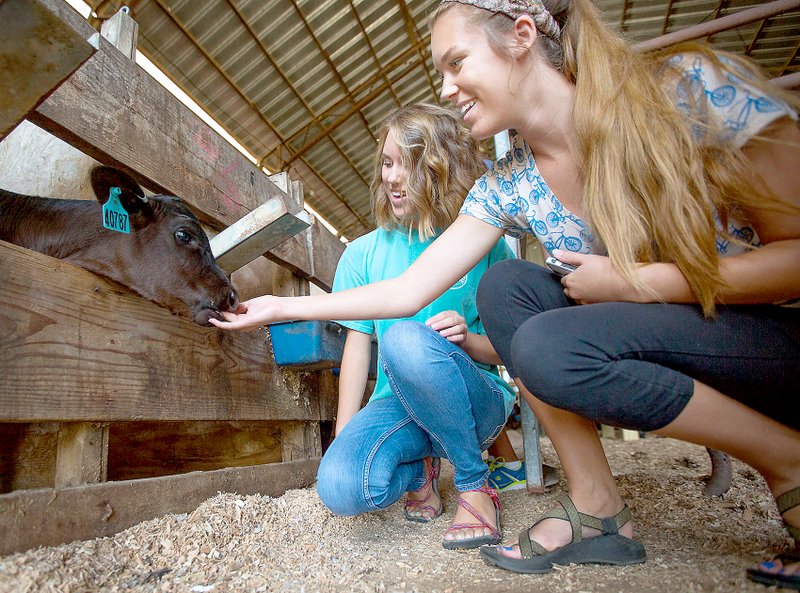CAVE SPRINGS -- The urban water cycle and conservation projects were focus points for teens at the Illinois River Watershed Partnership youth conservation leadership summit on Friday.
Teens toured Haak Dairy Farm in Gentry to learn about agricultural conservation. They visited Beaver Water District Water Treatment Facility to learn about the water they drink. They saw operations at Northwest Arkansas Conservation Authority wastewater plant. They also got a look at development of the watershed's sanctuary and learning center.
The Illinois River Watershed Sanctuary and Learning Center will open later this year at the partnership’s Cave Springs headquarters, 221 S. Main St. The 32-acre site will include hiking trails and a recreational water area at the former Lake Keith Resort and a learning center in the former Lakeview Baptist Church. The cave on the grounds of the sanctuary is home to the Ozark cave fish and gray bats, both endangered species. For more information on the partnership visit the website at www.irwp.org.
SOURCE: STAFF REPORT
The lake across from the partnership's offices has been drained to repair the dam under Main Street, said Delia Haak, watershed executive director. Students walked around the area that will eventually include trails and a launch for canoes, and they stopped at the back of the property to eye the water falling out of the protected cave.
The cave at the Illinois River Watershed is cool, teens said. The bats and Ozark cave fish are neat because they are endangered.
The partnership hosted a similar summit in January where youth leaders visited natural water resources, Haak said. Friday was a chance for them to see something different by learning about urban water use. The principles of conservation can be found in agriculture and in the municipal setting of a wastewater treatment plant, Haak said.
"Whatever field they're going into, they can practice conservation and be a leader," Haak said.
Lauren Ray, education outreach coordinator, talked to the group about low-impact development.
The urban water cycle is different than the one they've seen in school, Ray said. Rain bounces off streets and roofs and picks up pollutants as it runs off, rinsing them into waterways.
Urban green spaces, bios wells that filter water through rocks or soil before it's carried off into the water system -- or even a sidewalk shaded by a wall of plants growing on a trellis -- can lower the impact of a developed area, Haak said.
"Anything green is going to soak up water as opposed to anything that's paved," Haak said.
Ian Dexter, summer intern and a mechanical engineering student, talked with teens about the green roof pavilion he's designed for the sanctuary area. The live plants will have a cooling effect on the pavilion, and the guttering system is designed so they can try to measure runoff and absorption rates, Dexter said.
There are about 60 rain gardens in Northwest Arkansas, Ray told students.
"Everybody has a stake in the watershed and keeping our water quality high," she said.
Part of the goal for the day was for students to understand the municipal water supply and what happens to it once used, Ray said.
"A lot of people don't realize that water is discharged back into our waterway," Ray said.
The group toured the Northwest Arkansas Conservation Authority wastewater treatment plant where Mike Neil, assistant plant manager, showed students how grit and particles are filtered out before treatment; and he gave them a microscopic view of the ciliates that eat bacteria.
The plant strives for minimal impact in the water it releases back into the creek, Neil said. The bacteria level of water leaving the plant is lower than what might be found at any swimming beach.
Neil showed students the facility's computerized controls. They might learn the computer system in short order, but learning the science might take a little longer, he said.
"Basically, all we do is grow bacteria here," he said.
Abby Haak, a sixth-grader in Siloam Springs, said she didn't know before the tour untreated water is fed bacteria to eat contaminants.
Casey Wong, a freshman at Haas Hall Academy, has volunteered with Illinois River Watershed Partnership projects before. Her parents are adamant about keeping the planet clean. The family has made rain barrels and has a victory garden at home. She likes to know there is a way for her to make a difference, Casey said.
"You drink a cup of water, and you don't think about all the work that's gone into it," she said.
Conservation is important to water treatment, Neil said.
Water conservation in a home or business doesn't just save water resources, it saves energy where that water was treated, Neil said. Electricity is required to treat every drop of water that comes out of the faucet. In fact, tap water is treated twice.
"It's treated before it gets to you, and it's treated after it leaves you," he said.
General News on 08/06/2014
